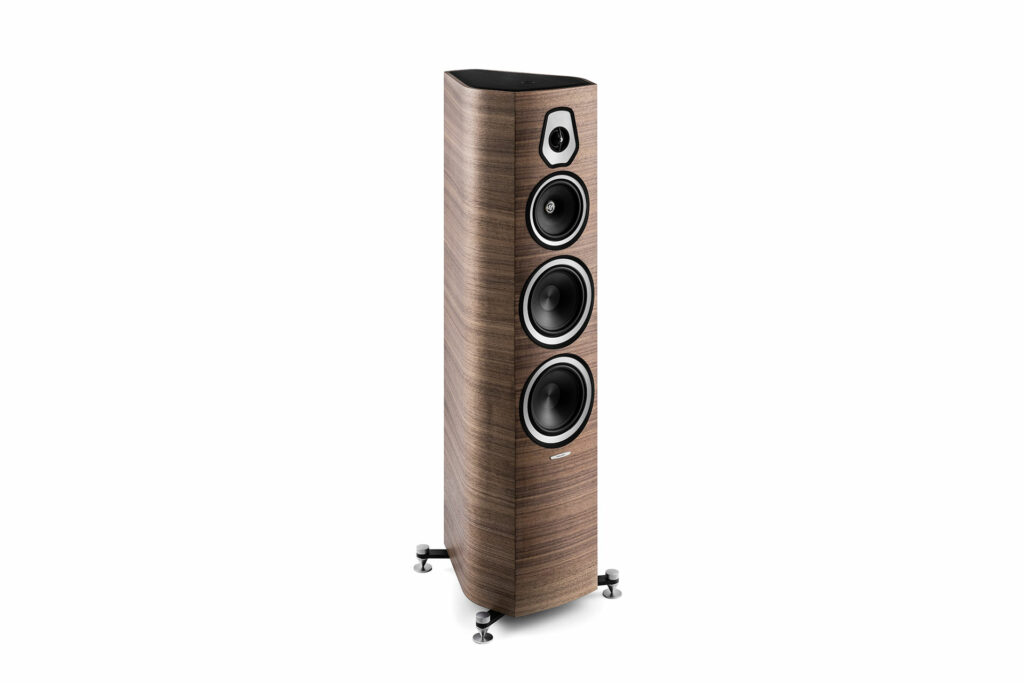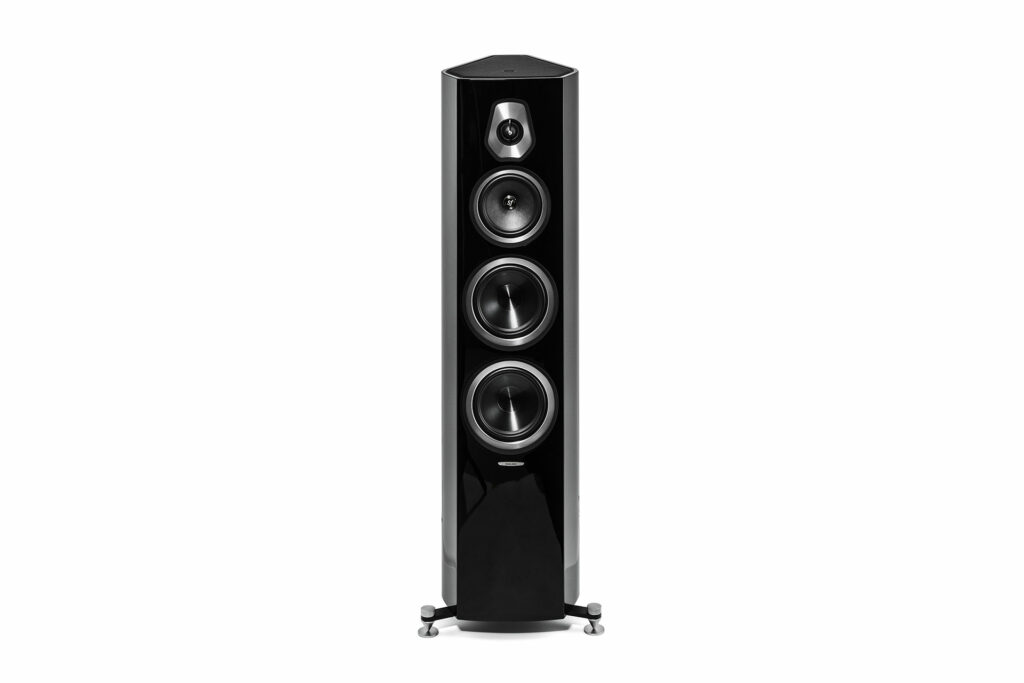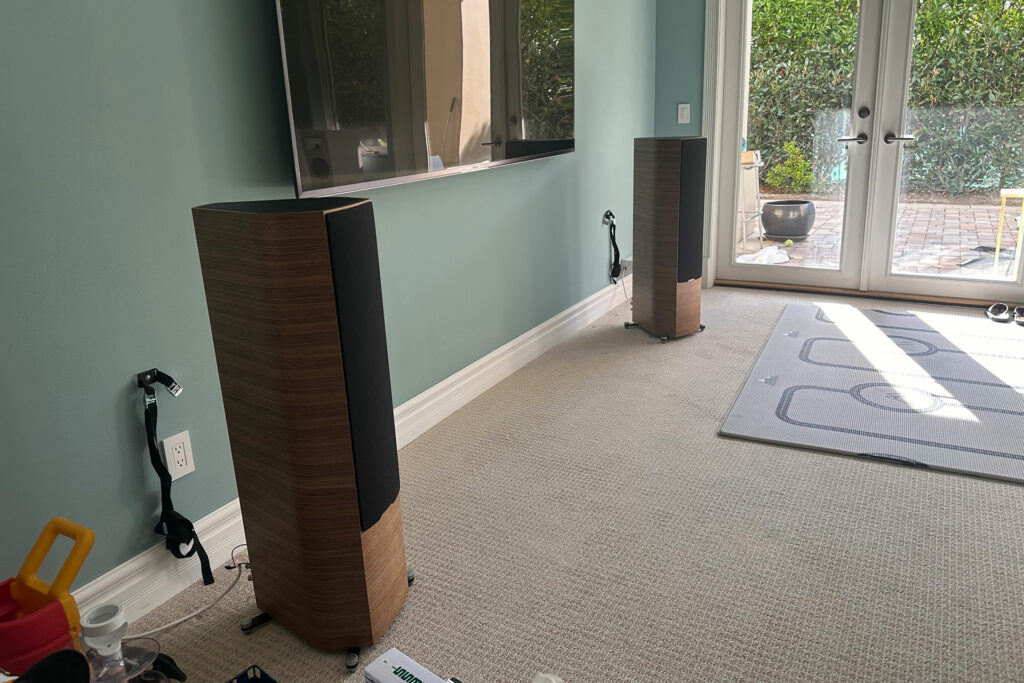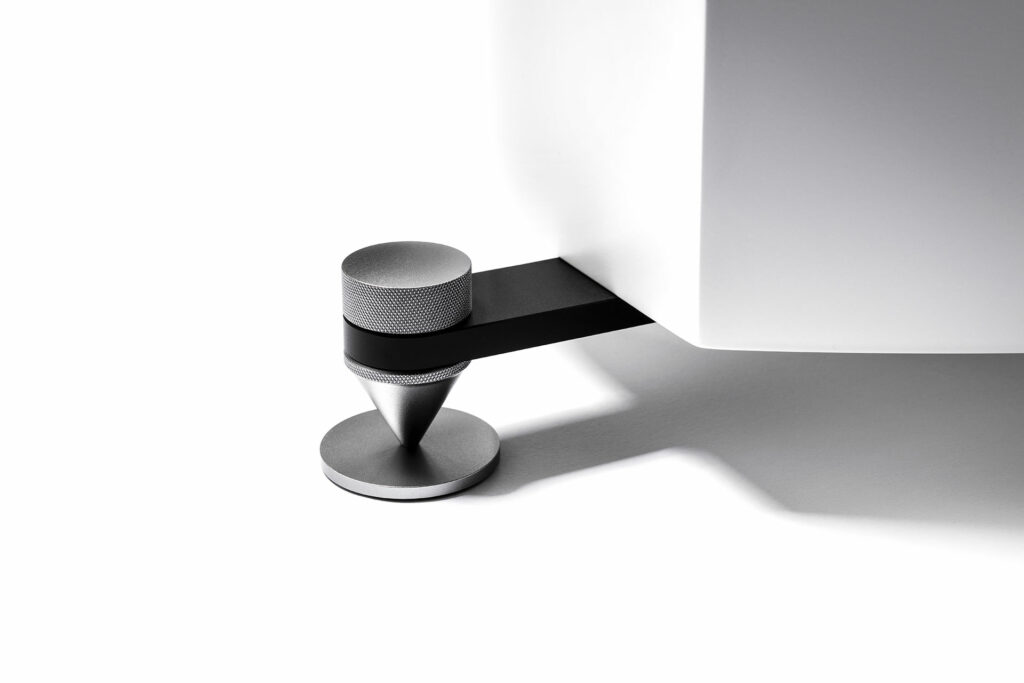Thirty years ago was the first time that I saw a Sonus faber bookshelf speaker. I was working in very high-end audio sales at Mark Levinson’s Cello Music and Film boutique, nestled in the Hollywood Hills right above Geffen Records, The Viper Room and Gil Turner’s (that will make sense to anybody who’s ever visited the Sunset Strip in West Hollywood), and these leather-wrapped speakers spoke to audiophiles like Joe Cali, Michael Fuschi, Nick Lucci, and all of the other I-talians that were my colleagues back then. Those legacy speakers had a gorgeous wooden finish, as well as leather wrapping, but could be driven by a receiver or a modest multi-channel distribution amp for a whole-home music system, thus allowing us to use audiophile bookshelf speakers over some (at the time) pretty weak-sauce in-wall speaker options. It didn’t take long before we were buying these speakers by the dozen – not one pair at a time.

Roll the tape forward to today, and Sonus faber is a brand under the umbrella of The McIntosh Group, along with other brands like Pro-Ject turntables. These days, Sonus faber now has high-end Italian automotive partners, including Maserati and Pagani. Until recently, Sonus faber sold their speakers in Magnolia Stories inside of Best Buy, as well as traditional audiophile and AV dealers. They have speakers that mainstream consumers can actually dream of affording, all the way up to ones that Elon Musk used at $140,000 per pair for his video game soundtrack in a 3.1 system when he used to live in the Brentwood neighborhood in West Los Angeles.
The Sonus faber Sonetto V is $4,999 per pair, a more entry-level pair of three-way floorstanding speakers that meet a lot of audiophile needs. They also come in a white and black finish, which would have also looked great in my media room, but they are more often presented in a walnut veneer and very nicely finished outrigger (aka: feet) hardware in a combination of aluminum and black.
The Sonetto Vs come with Sonus faber’s famous silk dome tweeter, which is possibly the most unique part of the sound of these speakers. They are a great size at 44 by 10 by 16 inches in a non-boxy cabinet design. They are substantial speakers, but not back-breakers, at just under 50 pounds when out of the box. They are 90 dB sensitive and carry a 4 ohm load, which makes them a little harder than average, but nothing worrisome in terms of how easy they are to drive. Do you need a pair of Sonetto Vs in your audiophile system? That’s what we are here to figure out, so let’s get into it…

What Makes the Sonus faber Sonetto V Speakers So Special?
- The look of Sonus faber speakers is what catches most people’s attention the first time that you see them, as they exude Italian style like Anthony Bourdain wearing a pair of vintage locally-made sunglasses that he picked up a thrift shop in Milan in between stuffing his face while shooting his old show on location. They are beautiful-looking, with careful attention paid to the small details. These speakers exude elegance both sonically and physically, when most other speakers in this class can deliver on both of these important fronts.
- The Sonus faber silk dome tweeter delivers the speaker’s signature sound. Not everybody loves the signature Sonus faber sound, but I do. My media room is a little echoey, yet the Sonetto Vs sound really balanced, be they powered by my top-of-the-line Marantz receiver or two of the seven channels of Halcro power that I send down to the front speakers in this media room system. Either power source could sonically make paint chips fly from the ceiling before the speakers (or my ears) gave out, thus again, I wouldn’t worry about too much power, as you likely could drive these with a PS Audio Sprout 100 or even some Chi-Fi option.
- The Sonus faber Sonetto Vs image fantastically well. We will get to the bass performance in a minute, but the imaging of the speakers is topnotch in my room. I didn’t use much toe-in and that made for a wider soundstage, which sounded great in my wide but not deep room.
- The down-firing bass reflex port makes the speakers easy to place near the rear wall without any real-world issues. The bass was good, too. I mean really good, in terms of both depth and control.
- Tip-overs are a major concern with a two-year-old at home, and the Sonus faber Sonetto V has really great and easy to install outriggers/feet. I learned recently from Andy Kerr, the head designer at Bowers & Wilkins, that there are very high standards for tip-overs in Europe, and these competing speakers do a great job of keeping your speakers from going over, unless shoved really enthusiastically.
- The grilles on the Sonus faber Sonetto V speakers are not the “stringy” ones from past designs from the Italian speaker company. The grilles are more traditional and, for that matter, the speakers are not quite of the finish of the more expensive models, which is fully understandable to save on build cost in order to bring them in at a $4,999 retail. I couldn’t hear a difference with the grilles on or off, so considering that Giovanni is interested in driving toy trucks on any possible surface in our home, I’ve decided to leave the grilles on.
- The binding posts benefit from their bigger Sonus faber siblings. They are easy to use with bare wire, which I was using, as well as physically staggered, which makes installation super easy and pretty damn fast.
Why Should You Care About the Sonus faber Sonetto V Speakers?
Traditionalist audiophiles will tell you that the only thing that matters with any audiophile component is the sound, and that is total bullshit (and we all know it). So much of what you pay for in an audiophile loudspeaker is about the small details, paired with the look and feel of the product. That’s why they are so expensive, and they are actually supposed to look great in your room. And sound great, too, and the Sonus faber Sonetto Vs deliver on both fronts.
If you are into classic Italian style, paired with world-class sound reproduction, you are a potential Sonus faber client, and you care about these speakers. They have the heritage, the craftsmanship and the performance that makes the $4,999 per pair price justifiable.

Some Things You Might Not Like About the Sonus faber Sonetto V Speakers…
- The silk dome tweeter images like a banshee (the mids do, too), but the highs are ever-so-slightly etched in the very top frequencies. The mids sound as open as can be expected from a traditional driver. I hate to call the Sonetto Vs bright, and I will not do that here. I might suggest that they are just a little bit analytical in the tippy-top frequencies, which actually results in some very good sonic outcomes that we will get into with the music examples below.
- While there is a white option, the walnut finish isn’t going to appeal to everyone. For the record, I love both of the finishes. I also love that they have a big center speaker for those who might use the Sonetto Vs for movie or TV sound playback, but the look of these speakers is just a little unique and will not be for everyone – and that’s fine.
- While the Sonus faber Sonetto Vs don’t need a sub, they loved being paired with my monstrous SVS SB-4000 powerhouse sub. With a reported 36 Hz bottom end, the Sonus faber Sonetto Vs are capable of bass that is well below where, say, a bass guitar will dive to, but a sub really helps allow the speaker to not have to stress to get those low notes at high volumes, thus the sound is even more coherent with a well-matched, but not necessarily expensive, subwoofer in play.
Listening to the Sonus faber Sonetto V Loudspeakers…
Historically, Peter Gabriel solo records aren’t the best audiophile demos, solely because of the recording quality from their respective eras, ranging from the 1980s well into the 1990s, with a few iconic albums along the way. A late 2023 release, Peter Gabriel’s i/o, breaks that mold and is a must-listen/own for any audiophile today. The song “The Court” (Bright-Side mix) is of specific note, as it had an incredibly intimate sound that highlighted the benefit of the silk dome tweeter when listening to the high-frequency sonic material like the percussion and chimes. Gabriel’s voice, in this specific mix, is a little bit more energetic, but has a raspy, close-mic’ed sound, with deep yet taut bass, and it just was ear candy on the Sonus faber Sonetto V speakers. With the Sonetto Vs barely toed-in, I got a very wide and compelling soundstage that extended well outside of the speakers in my shallow but wide media room listening area. Take a minute or two to check this track out, as it might be a new favorite demo for you, as it has become for me.
Sinatra at the Sands is an all-time classic 1966 recording that has no right to sound as good as it does in 2024. The engineers didn’t have 128-track mixing consoles and 24-track analog recording machines back in old Vegas (with “old Vegas” perhaps the best adjective in the English language right now) at the Sands, but that didn’t keep the Sonus faber Sonetto Vs from emotionally taking me back to a more simple time, when dirty martinis were as prevalent as dirty jokes intermixed with some of the most perfect versions of classic Sinatra song stylings. The Count Basie Orchestra was as good as the world knew in that era and, to add to the star power, they were being conducted by all-time great record producer Quincy Jones. The opening track “Come Fly With Me” works through a lot of musical introduction boiler plate but when Ol’ Blue Eyes gets to the main verse, the Sonus faber Sonetto Vs really shine. The silk dome tweeter delivers Sinatra in front of The Count Basie Orchestra with a lively, but not bright, musical energy. The orchestra is clearly defined and well-presented, yet never harsh or thin-sounding. Sinatra’s velvety smooth voice, as he was my age back then, thus about to turn 50, was still strong and vibrant when this performance was captured on magnetic tape. This opening song is a must-hear track for audiophiles of all ages, not just because of the time-defying sound, but because of the quality of the performance, paired with the historical significance of the performance. Check it out on Youtube.com here.
I’ve been listening more and more to my reference audiophile system with my wife as she’s learning more about the hobby, as well as the value of excellent but often clichéd albums, such as Fleetwood Mac’s all-time classic Rumours. In the past, long before this (late 2023-and-ongoing) experiment, she has called Rumours “skeezy,” as it was too 1970s-flavored for her, but now it has grown on her. You’d have to be dead or deaf for “Gold Dust Woman” not to give you some audiophile music-induced goosebumps. This mellow track has so much subtlety that, when listening using the Sonus faber Sonetto V speakers, you can hear layering and detail like the flanger or phaser effect on one of the guitar tracks. The acoustic guitar leads pop out front of the mix with a lively and pretty presentation. The background vocals are so wonderfully layered that you can’t help but love this song as a way to highlight what is great about an audiophile system, without having to delve into lame performances or geeky songwriting that you find in many audiophile recordings.
Will the Sonus faber Sonetto Vs Hold Their Value?
By any measure, Sonus faber in 2024 is an A-list audiophile speaker brand. It sucks that they just got the boot from Magnolia to make room for KEF, but shit happens and they will live. The hundreds of thousands of people who heard and loved these speakers over the years in all of those stores still likely have positive feelings, just like in-the-know audiophiles who also know and love the said full range of speakers from Sonus faber.
Like any audiophile speaker in this price range, you won’t get every penny back on your investment, but after a few years, I would set your expectations to get 40 to upwards of 50 cents on the dollar for your investment for a well-cared-for pair of Sonus faber Sonetto V speakers. That’s a pretty good value proposition in today’s audiophile world.
Who is the Competition for the Sonus faber Sonetto V Speakers?
The Bowers & Wilkins 704 S3 speakers (buy at Crutchfield) come priced at about 20 percent less than the Sonus faber Sonetto V loudspeakers, and have a similar finish and size. Sonically, they also come with a somewhat forward-sounding but highly-refined tweeter, so there are some sonic similarities to discuss here. There are a few really pretty finish options from this A-list speaker manufacturer from the U.K., which is always worthy of note at these price points, especially a black option. The bass on the Sonus faber comes across more present and perhaps a little deeper on the Sonus faber Sonettos, while the high frequencies are a little more to my tastes with the Bowers & Wilkins.

The GoldenEar Triton 2+ speakers ($5,500 per pair – buy at Crutchfield) come with an AMT tweeter, which provides a more open, electrostatic-like sound, as compared to the Sonus faber Sonetto Vs at about the same price. The fit and finish of the GoldenEars are not really comparable, even if the price is, but the openness of the AMT tweeter and the really strong, in-speaker bass driver or subwoofer is the draw with the GoldenEar, which is a very different company now that they are owned by AudioQuest.
Andrew Dewhirst just reviewed the MartinLogan XT F100 floorstanding speakers at about $4,500 per pair (buy at Crutchfield) and just loved them. They too have an AMT tweeter, thus a different high-frequency sound, but they are priced in the same ballpark. The MartinLogan XT F100s (read the review) both have punchy yet tight bass. They both have excellent outrigger feet for tip-over prevention. The cabinets on the MartinLogan aren’t as sexy as the Sonus fabers, as they don’t have as many unique lines, thus are physically boxier.

Final Thoughts on the Sonus faber Sonetto V Loudspeakers
Not every audiophile wants to invest their hard-earned audiophile money on great-sounding but physically ugly products. To be a little bit mean, Morris Kessler makes a great Class-AB amp at ATI at a very fair price, but God-damn they are utilitarian-looking, and that, for many of us, that takes a little of the fun out of the audiophile courting process. More often than not, we want a silver anodized aluminum case packing new-school Class-D amp technologies like GaN Gallium Nitride (learn more here) included, with gauges that look like you stole them from an E-meter designed to measure your Thetans at the local Scientology center. Thankfully, Sonus faber Sonetto Vs deliver in both the sound category and in the Brioni-wearing, Italian good looks department.
In switching back and forth between Marantz power and much more high-end Halcro power, I see how the Sonus faber Sonetto Vs are the type of speaker that could be along with you in your audiophile journey for years to come. These speakers will give you better performance the more than you are able to give to them, be it high-resolution source material, excellent electronics, better room acoustics, and perhaps a modest but capable subwoofer.
These $4,999 per pair speakers strike a balance in terms of value proposition that will be very appealing to many new-school audiophiles, as well as many of the old guard. These speakers can do it all, as well as look the part, and that is a very strong buy opportunity at $4,999.




Hello Jerry. Thankyou for the impressive and detailed review. I own a pair of B&W CM9 S02. They are great, but i think that i miss something when listening to music, i really don’t know how to explain……they do not sound to me very warm…….They sound some analytical……. I have an opportunity to exchange them to those Sonus Faber Sonetto V or the Whaferdale EVO 4.4……….i am really in doubt……if you can talk some words, i would appreciate. My Amp is a Hegel H190 and have multiple sources of players like CDs, LPs and digital.
Speakers are very personal. Your list is an excellent one. You can’t miss with those options. 🙂
Hello Jerry, What is the lowest Impedance that these Sonetto V speakers go down to? Thanks in advance.
Richard,
Good morning.
I/we don’t measure that statistic for our reviews as the standard “efficiency” is normally a reliable number.
I drove them on a 7-channel Halcro amp with 100 WPC. Nothing too crazy.
I didn’t think these were hard to drive at all with a reasonable amp.